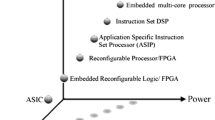Abstract
This paper presents the algorithm and reconfigurable architecture of motion-adaptive deinterlacer for high-definition video. The content-adaptability of algorithm and the reconfiguration of architecture are concurrently explored by algorithm/architecture co-design methodology and Caltrop actor language (CAL) modeling of the dataflow. In the design methodology we employed, the CAL dataflow model is also very helpful in the verification of our deinerlacer. The proposed algorithm and architecture design of deinterlacer is more cost-efficient than two recently proposed works in terms of algorithmic performance and silicon area of VLSI implementation. Moreover, data path reconfiguration efficiently enables various interpolation schemes using less computational resource of hardware than non-reconfigurable architecture.





Similar content being viewed by others
Reference
Bondalapati, K., & Prasanna, V. K. (2002). Reconfigurable computing systems. Proceedings of the IEEE, 90(7), 1201–1217.
Nikolaos, S. V., & Konstantinos, M. (2005). System Level Design of Reconfigurable Systems-on-Chip. Secaucus, NJ: Springer.
Shoa, A., & Shirani, S. (2005). Run-time reconfigurable systems for digital signal processing applications: A survey. J VLSI Signal Process Syst Signal Image Video Technol, 39(3), 213–235. doi:10.1007/s11265-005-4841-x.
Mei, B., De Sutter, B., Vander Aa, T., Wouters, M., Kanstein, A., & Dupont, S. (2008). Implementation of a coarse-grained reconfigurable media processor for AVC decoder. J Signal Process Syst, 51(3), 225–243. doi:10.1007/s11265-007-0152-8.
Liang, L., McCanny, J. V., & Sezer, S. (2007). “Reconfigurable Video Motion Estimation Processor,” Proceedings of Anniversary IEEE International SOC Conference (pp. 55–58) Hsinchu, Taiwan.
Vogt, T., & Wehn, N. (2008). A Reconfigurable ASIP for Convolutional and Turbo Decoding in an SDR Environment. IEEE Transactions on Very Large Scale Integrated System, 16(10), 1309–1320. doi:10.1109/TVLSI.2008.2002428.
Veljanovski, R., Stojcevski, A., Singh, J., Zayegh, A., & Faulkner, M. (2003). A Low Cost Reconfigurable Architecture for a UMTS Receiver. IEICE Transactions on Communications, E86-B(12), 3441–3451.
Lee, G. G., Jang, E. S., Mattavelli, M., Tsai, C-J., Lucarz, C., Raulet, M., & Ding, D. (2008). “Text of ISO/IEC FCD 23001-4: Codec Configuration Representation,” ISO/IEC JCT1/SC29/WG11 MPEG w9772, Archamps, France, Apr. 2008.
Tung, Y-S., Lee, G-G., Jang, E. S., Lee, S., Asai, K., Yamada Y., & Mattavelli, M. (2008). “FCD ISO/IEC 23002-4: Video Tool Library,” ISO/IEC JCT1/SC29/WG11 MPEG w9774, Archamps, France, Apr. 2008.
de haan, G., & Bellers, E. B. (1998). Deinterlacing – an overview. Proceedings of the IEEE, 86(9), 1839–1857.
Lee, G. G., Lin, H-Y., Su, D. W-C., & Wang, M-J. (2007). Multiresolution-Based Texture Adaptive Algorithm for High-Quality Deinterlacing. IEICE Transaction on Information and System, E 90-D(11).
Chang, Y. L., Lin, S. F., Chen, L. G. (2004). Extended intelligent edge-based line average with its implementation and test method. Proc Int Symp Circuits Syst, 2 (May), II-341–II-344.
Kuo, C. J., Liao, C., & Lin, C. C. (1997). Adaptive interpolation technique for scanning rate conversion. IEEE Transactions on Circuits and System Video Technology, 7(3), 539–542. doi:10.1109/76.585932.
Lee, G. G., Wang, M-J., Lin, H-Y., Su, D. W-C. & Lin, B-Y. (2007). Algorithm/Architecture Co-Design of 3D Spatio-Temporal Motion Estimation for Video Coding. IEEE Transactions on Multimedia, 9(3), Apr.
Lee, G. G., Wang, M-J., Lin, H-Y. & Lai, R-L. On The Efficient Algorithm/Architecture Co-Exploration for Complex Video Processing. IEEE International Conference on Multimedia & Expo (ICME 2008).
Khawam, S., Nousias, I., Milward, M., Yi, Y., Muir, M., & Arslan, T. (2008). The Reconfigurable Instruction Cell Array. IEEE Transactions on Very Large Scale Integrated System, 16(1), 75–85. doi:10.1109/TVLSI.2007.912133.
Ansaloni, G., Bonzini, P., & Pozzi, L. (2008). Design and architectural exploration of expression-grained reconfigurable arrays. IEEE Symposium on Application Specific Processors, Anaheim Convention Center, California, June 8–9, 2008.
Jung, S., & Kim, T. G. (2008). An operation and interconnection sharing algorithm for reconfiguration overhead reduction using static partial reconfiguration. IEEE Transactions on Very Large Scale Integrated System, 16(12), 1589–1595. doi:10.1109/TVLSI.2008.2000973.
Moreano, N., Bonn, E., De Souza, C., & Araujo, G. (2005). Efficient Datapath Merging for Partially Reconfigurable Architectures. IEEE Transactions on Computer Aided Design of Integrated Circuit and System, 24(7), 969–980. doi:10.1109/TCAD.2005.850844.
Lee, G. G., Wang, M-J., Li, H-T., & Lin, H-Y., “A Motion-Adaptive Deinterlacer via Hybrid Motion Detection and Edge-Pattern Recognition,” EURASIP Journal on Image and Video Processing, Volume 2008, Article ID 741290, 10 pages, Mar. 2008.
Lee, H.Y., Park, J.W., Bae, T.M., Choi, S.U., Ho, Y. (2000). Ha, Adaptive scan rate up-conversion system based on human visual characteristics. IEEE Trans. Consum. Electron. 46(4).
Yoo, H., & Jeong, J. (2002). Direction-oriented interpolation and its application to de-interlacing. IEEE Transaction on Consumer Electronics, 48(4), 954–962.
Gonzalez, R. C., & Woods, R. E. (2002). Digital Image processing. Upper Saddle River, NJ: Prentice-Hall.
Lee, G. G., Lin, H-Y., Wang, M-J., Lai, R-L., Jhuo, C. W. & Chen, B-H. "Spatial-Temporal Content-Adaptive Deinterlacing Algorithm,” IET Image processing, Vol. 2, No. 6, pp. 323–336, Dec. 2008.
Eker, J. & Janneck, J. W. “An introduction to the Caltrop actor language,” available at: http://embedded.eecs.berkeley.edu/caltrop/index.html
Lee, G. G., Lin, H-Y., Wang, M-J., Chen, B-H., & Cheng, Y-L. “On The Verification of Multi-Standard SOC’S for Reconfigurable Video Coding Based on Algorithm/Architecture Co-Exploration,” in Proc. of IEEE 2008 Workshop on Signal Processing Systems (SiPS 2008).
Lin, C., Wei, C-J., Sheu, M., Chiang, H., & Liaw, C. (2006). “The VLSI Design of deinterlacing with scene change detection.” IEEE International Symposium on Circuits and Systems, Island of Kos, Greece, May 21-24.
Sun, H., Zheng, N., Ge, C., Wang, D., & Ren, P. “An efficient motion adaptive de-interlacing and its VLSI architecture design,” Proceedings of IEEE Computer Society Annual Symposium on VLSI, Montpellier, France, Apr. 2008, pp. 455–458.
Author information
Authors and Affiliations
Corresponding author
Rights and permissions
About this article
Cite this article
Lee, G.G., Wang, MJ., Chen, BH. et al. Reconfigurable Architecture for Deinterlacer based on Algorithm/Architecture Co-Design. J Sign Process Syst 63, 181–189 (2011). https://doi.org/10.1007/s11265-009-0388-6
Received:
Revised:
Accepted:
Published:
Issue Date:
DOI: https://doi.org/10.1007/s11265-009-0388-6




